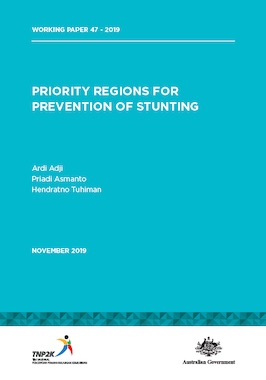Priority Regions for Prevention of Stunting
One aspect of Indonesia’s health profile that still needs improvement is stunting. In 2018 Indonesia had one of the highest prevalence rates for stunting in the world at 30.8 percent. To achieve the National Medium- Term Development Plan 2015-2019 (Rencana Pembangunan Jangka Menengah Negara: RPJMN) target of a 28 percent stunting rate, in 2018 the government set priority areas for stunting prevention in 100 districts/cities through a program that will be expanded gradually until 2021. This study is intended to provide a technical explanation for the selection of districts/cities and villages/kelurahan as priority areas for stunting prevention.
The indicators used in determining priority areas for stunting prevention at the district/city level include: (i) the total number of poor people; (ii) prevalence of stunting in children under the age of five years; and (iii) total number of children under the age of five years with stunting. At the village and kelurahan level, priority areas are determined using indicators adjusted to those used in preparing the index at district and city level, namely: (i) total population; (ii) total poor population; (iii) poverty rate; and (iv) total occurrences of malnutrition. Determination of priority areas uses a weighted average index, at both the district/city level and village/kelurahan leve
